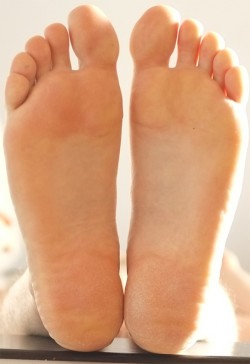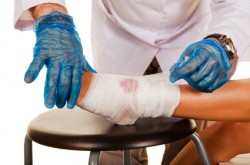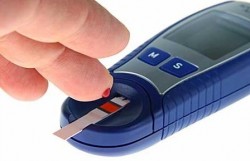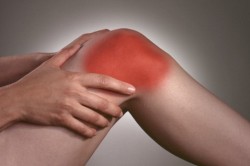There is another formidable complication that can lead to amputation of the lower extremities, feet, legs ... All these are the deposits of the developed diabetic foot syndrome, occurring according to statistics from 80% of patients with diabetes.
General Syndrome Information

This syndrome as a separate problem began to be considered by scientists only from the middle of the last century. In those years, another section appeared in medicine, which began to intently study the diseases of the stop, named podiatriy. Endocrinologists, vascular surgeons, orthopedists began together to offer possible assistance options to suffering diabetes. It was observed that ten times more often the sickness of the feet occurs in patients, diabetes caused by the type II type. With a long elevated level of glucose in the bloodstream, the nerves, blood vessels located in the lower limbs occur. The full blood supply to the legs (angiopathy) is disturbed, neuropathy is recorded, that is, there is a violation of communication, the interaction of organs and tissues with the central nervous system). When the blood circulation in the vessels is broken, the oxygen to the skin, muscles, joints, the bones do not flow, about it, the edema of the feet, the legs, pain in the ion muscles, periodically repeated cramps in the lower extremities. The sensitivity of the skin with neuropathy is noticeably declining, there is even a feeling of numbness of some fields of legs. Diabetik does not notice that the shoes are inconvenient that small extraneous objects (sand, pebbles, twigs) were hit in her (sand, pebbles, twigs), so hurts appear, ranks. Danger still lies in diabetes very bad and difficult to heal all wounds. Even minor injuries (crack, corn, scratch, bruise, abrasion, cut when cutting nails) are fraught with heavy consequences. For example, purulent unlocking wounds, phlegmon, trophic ulcers, osteomyelitis of bone tissues, gangrene. And if the patient does not appeal for help for help to doctors, then surgeons have to carry out an amputation of a part of the limb to save the suffering life. In long-year-suffering diabetes, the structure of bones and foot joints is gradually disturbed, their friction occurs, seed, deformation, flatfoot, Loss of spring function. This is the phenomena of osteoarthropathy. When the bones are signed, there are high-load zones in some sections of the foot. Most often on the heel region and the plantar surface of the fingers are formed ulcerative defects. There is even a medical term - Stop Charcot.
The percentage of complications in the footsteps are more from those who:
- For a long time, the concentration of blood sugar cannot reduce;
- suffer from excess weight, Atherosclerosis;
- smokes, abuses alcohol.
Signs that should alert

Medicas believe that the amputations of the limbs can be prevented from suffering from diabetes, provided that such patients will be at the very first signs of the development of the diabetic foot to seek help from the specialists engaged in this problem, and then fulfill all their treatment recommendations. Methods for treating the diabetic foot, of course, depend on the stage and form of the disease. As a rule, an integrated approach includes the following directions:
- Local treatment - Processing of wounds with antiseptics, hydrocoleloid dressings.
- Improvement of blood flow by reception of drugs (pentoxifillain, normen, Aktovegin).
- Antibacterial therapy.
- Reducing the load on the affected limb.
- Permanent care for «patients with places».
In severe cases, surgical treatment is shown.
In recent years, modern effective methods of vascular surgery are actively introduced, the purpose of which is to restore blood flow in damaged lower limbs, such as stenting, cylinder. Thanks to the continuous improvement of methods, the doctors manage to restore the functioning of not only patellied and femoral arteries, but also smaller arteries located in the leg and foot. This operation is carried out by gentle way: punctors are made on the sore leg, then catheters are introduced into the artery, with the help of which, using special cylinders, surgeons are trying to expand closed vessels, thereby restoring their permeability. After all, it is the complete closure or a narrowing of the vessels and leads to the necrosis of the fabrics, that is, their dying. When the clearance of the vessel is restored, then the so-called stents (metal frames) are inserted into it so that these vessels can not be released again.
Preventive measures

All people who are diagnosed «diabetes» It is necessary to know and respect the rules very important for their life, which are able to delay and prevent serious complications.
It is strongly recommended:
- Conduct strict control of blood glucose levels, because now there is homemade glucometters.
- Control your hell, weight, pass periodically analyzes on the amount of cholesterol in the blood.
- Come to consult your attending endocrinologist.
- Socks wear only cotton or woolen, be sure to. Daily change them, pre-wash your legs. Sharp socks are better to avoid, as well as tight rubber bands. On bare feet shoes do not wear.
- Do not save on shoes. Choose it from the skin or other elastic material that is able to stretch, take the form of your foot. Do not take close shoes, which presses in the field of fingers, has internal seams. The sole should not be flat or slippery, is desirable small, comfortable heel (or platform), availability «Lipuchek» or cords that allow you to adjust the width. Some patients show special orthopedic shoes tailored to order in the workshop.
- Clear your shoes regularly. Pay attention to the wrong insoles, microscopic cloves or brackets did not get out, did not get pebbles or sorties.
- Insoles need to be purchased only for diabetics.
- Try to make hiking for about two hours every day, do not neglect the special gymnastics for stop, then the muscles and vessels of the legs will be maintained in a tone.
- If there are bundles, darkening of nails or signs of skin diseases, then refer to a dermatologist.
- If cuts appeared, abrasions, then they should be processed immediately Miramistine, Dioxidine, Chlorhexidine, and then carefully impose a sterile bandage. Do not use green, iodine, manganese, alcohol. WITH hydrogen peroxide also need to be careful.
What should be done every evening?
- Carefully examine the foot. There should be no damage resulting «Gate» For the passage of infectious agents.
- Warm water washing legs using baby soap. Then carefully wipe them with your foot towel.
- If necessary, sign nail plates.
- In the presence of corns, they can be lost pumice, unpack and cut it. All plasters, ointments and creams to use only with the permission of the doctor.
- Sometimes it is necessary to lubricate the legs with a softening anti-inflammatory, vitamined cream that the doctor recommended. Stellanin-PEG, Sulodekside, Actovegin is often appointed to accelerate wound healing.
What can not be done by suffering diabetes?
- Wearing other people's socks and shoes.
- Walking on the street, dacha, beach barefoot.
- Wash your feet with hot water, soar them, visit the bath.
- Make baths with salt, use advertised tools from calluses, without consulting pre-with a doctor.
When urgently need to consult a doctor?

Do not attempt to make independent measures to cure and get rid of the following cases:
- When detecting Ingrown nail;
- The appearance of pulbs, wound, corns, holing, burns;
- reduce or loss of feet sensitivity;
- pain in caviar while walking alone;
- darkening of the fingers, the appearance of specks and redness on them;
- Education of suppuration and ulcers.
Initial assistance to patients with diabetic foot syndromes should always have endocrinologists and surgeons of the clinics to which it is attached and consists in taking into account. But effective and qualified assistance can only be obtained only in specialized clinics, centers (or branches) dealing with diabetic foot problems. When complications, try as soon as possible to get there direction. Keep diabetes «in urde», To slow down the development of vascular complications.









